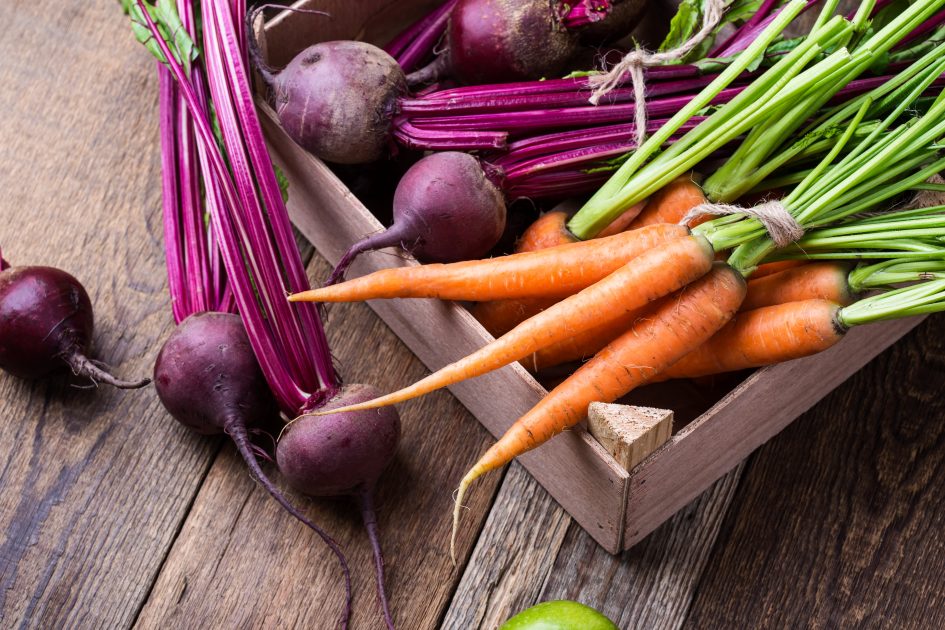Winter can be dull and depressing, but why should the root vegetables you eat during this time be the same? Let’s face it: winter root vegetables like rutabagas and parsnips are often overlooked and underappreciated. These root vegetables along with several others are not only available in winter when it’s hard to find other vegetables, but they are also inexpensive and chock full of nutrients. That’s why we’re featuring root vegetables along with their health benefits, as well as a combination recipe of delicious rosemary biscuits and a vegetarian gravy made from root vegetables to top them off.
Potatoes: Potatoes are packed with health-promoting phytonutrients and are rich in potassium (more so than bananas). Research suggests potatoes have many properties that may lower blood pressure.
Sweet potatoes: Sweet potatoes are one of the highest sources of vitamin A, an antioxidant powerhouse that is linked to cancer prevention, the maintenance of good eyesight and anti-aging benefits.
Parsnips: Parsnips contain folate, which promotes nervous system health, aids metabolism and is vital for pregnant woman because it decreases the risk of birth defects in newborn infants.
Rutabagas: One medium rutabaga contains more than 150 percent of the recommended Daily Value (DV) of Vitamin C, which is vital to many functions in the body and may help prevent cancer by protecting cells against harmful free radicals.
Beets: Studies have shown beets may help lower blood pressure due to nutrients they contain that help increase blood flow and deliver oxygen to parts of the body lacking it.
Carrots: Originally grown as medicine due to their nutritional properties, carrots are loaded with beta-carotene, which is used to prevent and treat serious medical conditions. A single carrot also provides more than 200 percent of the recommended DV of vitamin A. Many health authorities recommend getting both nutrients by eating produce rather than through supplementation.
Tip: Opt for healthier cooking methods, such as roasting, steaming or baking in lieu of methods that rob vegetables of valuable nutrients like frying.
Root Vegetable Breakfast Gravy & Rosemary Biscuits
Try this delicious twist on traditional biscuits and gravy by making a hearty gravy out of rich root vegetables and placing it atop a fragrant rosemary biscuit.
Biscuits
Ingredients
- 1 1/4 cups all-purpose flour
- 1/2 cup whole-wheat flour
- 1 1/2 tablespoons minced, fresh rosemary
- 2 1/2 teaspoons baking powder
- 1/3 cup solid-state coconut oil
- 1/2 cup plus 3 to 4 tablespoons milk, plus extra for brushing
- 1/2 teaspoon salt
- Pinch of pepper
Directions
- Preheat the oven to 400 F. Line a baking sheet with parchment paper and set aside.
- In a large bowl, whisk together the two types of flour, rosemary, baking powder, salt and pepper. Add in the coconut oil and use a pastry cutter to cut the oil into the flour. Continue until it resembles evenly sized crumbs.
- Add in the milk and mix until the dough comes together. (Start with the extra 3 tablespoons and add the fourth if the dough is too dry.)
- Dump the dough onto a well-floured surface. Pat the dough into a circle that is about three-fourths of an inch thick. Using a floured biscuit cutter (or the rim of a glass), cut out rounds from the dough and place on the prepared baking sheet. Combine the scraps and cut out additional biscuits until the dough is used up (this will be about five biscuits using a 3-inch biscuit cutter). Brush the tops of the biscuits lightly with milk.
- Bake for about 15 to 16 minutes until they are very light golden brown (they will barely brown in the oven).
Gravy
Ingredients
- 3 tablespoons butter
- 3 tablespoons flour
- 5 cups cold milk
- 3 cups of raw root vegetables for roasting
- Salt and pepper
Directions
- Preheat oven to 350 F.
- Peel and chop all the vegetables.
- Toss vegetables in olive oil, place in a pan and bake for 45 minutes (or until veggies are cooked enough to put a fork through). Once veggies are done, melt butter in a saucepan.
- Add flour to melted butter and stir constantly with a whisk until it’s well incorporated and there are no longer lumps.
- Cook on medium heat for about five minutes to get rid of the raw flour taste. Stir occasionally or constantly (whichever you prefer) to prevent it from browning.
- Add the cold milk slowly, whisking the entire time. (This may get lumpy, but keep whisking.) Whisk on medium heat until it begins to thicken, then add roasted vegetables. If you want a smoother consistency, you can puree the veggies into the sauce with an immersion blender.
- The longer you cook the gravy the thicker it gets, so cook it until it is the desired consistency and add salt and pepper to taste.
- Pour over your homemade rosemary biscuits and enjoy!
“Potatoes: Health Benefits, Risks & Nutrition Facts,” Jessie Szalay, livescience.com, Oct. 9, 2014.
“The Health Benefits of Parsnip,” Michelle Kerns, healtheating.sfgate.com, accessed Jan. 5, 2016.
“What’s So Great About Rutabaga?” Center for Nutrition, Diet and Health, udc.edu, accessed Jan. 8, 2016.
“5 Fun Facts About Carrots,” Chloe Thompson, webmd.com, May 8, 2014.
“Beetroot Benefits,” WebMD, webmdboots.com, accessed Jan. 11, 2016.
Gravy recipe adapted from indianapublicmedia.org
Rosemary biscuits adapted from ohmyveggies.com


